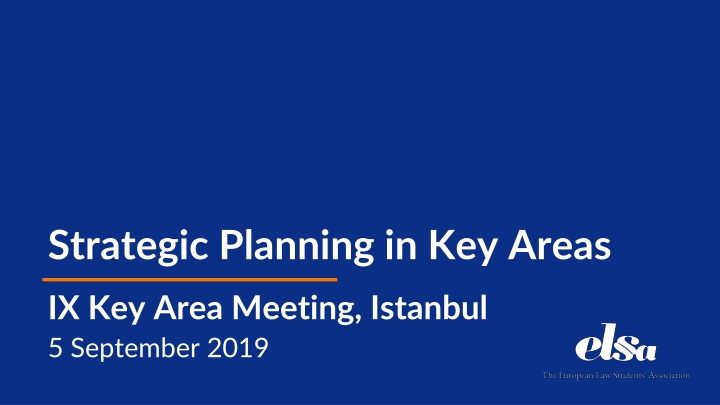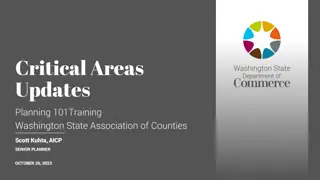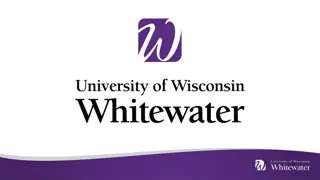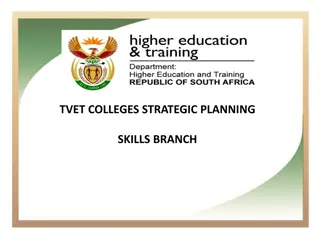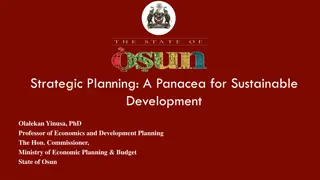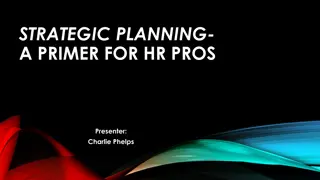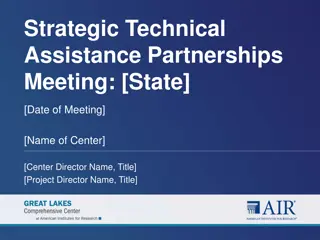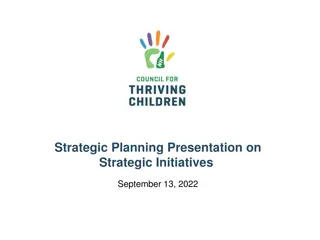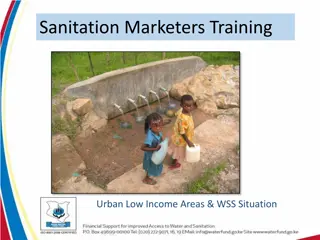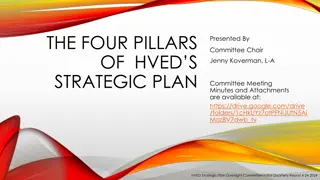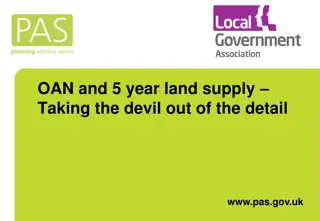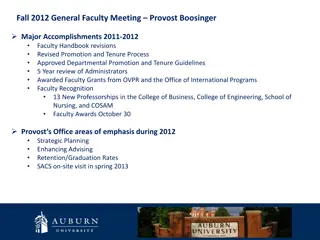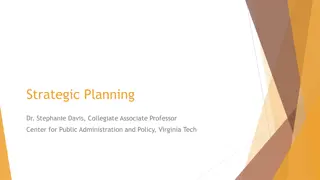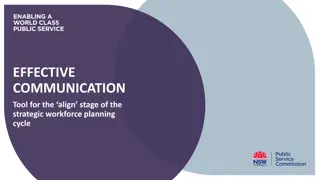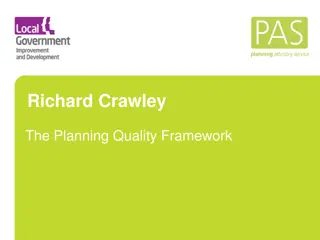Strategic Planning in Key Areas: Meeting Insights
Explore the importance and history of strategic planning, learning valuable lessons for coherent project development. Gain insights on strategic planning for new and existing projects, including SWOT analysis and setting goals in alignment with the strategic direction of ELSA.
Download Presentation

Please find below an Image/Link to download the presentation.
The content on the website is provided AS IS for your information and personal use only. It may not be sold, licensed, or shared on other websites without obtaining consent from the author.If you encounter any issues during the download, it is possible that the publisher has removed the file from their server.
You are allowed to download the files provided on this website for personal or commercial use, subject to the condition that they are used lawfully. All files are the property of their respective owners.
The content on the website is provided AS IS for your information and personal use only. It may not be sold, licensed, or shared on other websites without obtaining consent from the author.
E N D
Presentation Transcript
Strategic Planning in Key Areas IX Key Area Meeting, Istanbul 5 September 2019
The Purpose Shared sense of direction Giving purpose and context Focus our energy and resources Streamlining project management Creates accountability Increases member and partner value
Why is Strategic Planning necessary? How did we get here to here?
Very brief history lesson Late 1980 s: ELR the first AA project is born 1995: IFP is born Mid 1990 s: ELR turns to SPEL 1996: ELSA s first LRG (lasted 3 years) 2003: EMCC is born 2010: SPEL dies 2011: VP MCC is born (AA no longer does MCCs) 2012: LRG is institutionalised with a timeline 2013: Manual for SAP 2013: ELSA Day and EHRMCC are born (latter done by VP MCC) 2015: ELR is resurrected 2017: ELR (temporarily) discontinued + EHRMCC moved to VP AA 2018: EMCC turns to Jackson Tbc .
The lessons is 1. Coherent projects require long-term planning 2. Development and change take time 3. Our projects should be intentionally contributing to the philosophy statement of ELSA
Strategic Planning for New Projects A need for the project blue ocean strategy Cost/benefit analysis: Does the project bring more value to members, partners and the network than the resources spent organising it? Setting goals: Where is the project in 6 months 1 year 5 years and how do you get there?
Development of Existing Projects SWOT analysis Strengths Weaknesses Opportunities Threats
The Structure 3 Goals 10 Foci Operational Goals to do list
Three Main Goals Good Governance Living Vision An Engaging Association
Good Governance Annual ELSA Cycle meeting Board Reform Advisory Board Secretariat Reform
Advisory Board AIM Create an ELSA Advisory Body that consults the International Council and the IB on long-term projects and planning, by giving advice, improving knowledge management and transition. Statutory changes Clear Mandate Boundaries between the IB and the AB An immediate past board member, an Alumnus and external consultants
Board Reform AIM Ensure the sustainability of ELSA by allowing the IB to effectively fulfil its mandate. Tasks and duties of each IB Member Number of IB Members Professional Training for IB and outsourcing some tasks to professionals Focus on HR, IT, External Relations and Marketing Strategy
Secretariat Reform AIM Ensure the sustainability of ELSA by establishing a professional Secretariat, responsible for the day-to- day management and administration. Research the legal and financial implications of having a Secretariat Duties and responsibilities of such an organ (Mandate) Call to Association Management Companies Research for applicable grants on such expenses
Annual ELSA Cycle meeting AIM Developing a performant annual cycle meeting allowing ELSA to plan, review and evaluate the goals to be accomplished during the calendar year. Revision of current timeframe of the international events Adopt Quality Standards for international events Research on e-voting! Clarify what BEE really means and what is the goal and the scope of the 2nd IPM Checks and Balances between IB and Council after spring ICM Research on e-voting!
A Living Vision Speak out Refocus Continuity
AIM Strengthen the ELSA identity by creating a clear understanding of what the purpose statement means for today s members, in different countries and settings and how it defines and determines our actions. Refocus Define what non political means within international association law and practice Create a clear understanding of the purpose statement of ELSA Develop Human Rights awareness by aligning certain activities with these goals / Human Rights Partnerships Acknowledge legal matters and encourage Social Responsibly through a holistic approach Strategic plan to increase the awareness and knowledge of IFP
Speak Out AIM Be thevoice of European Law Students. ELSA Advocacy Programme; Define what ELSA Advocacy means for our members Research the legal, financial and reputational implications of an ELSA Advocacy Programme Develop awareness on the Rule of Law and UN Sustainable Development Goals Advocate on matters that concern law students
Continuity AIM Ensure a more cohesive, mutually beneficial and long-term relationships with the partners of ELSA, as well a its Officers and Members. Secure support from partners, institutions and persons New ways of involving our partners and trainers in the work of ELSA Highlight the success of its past members (i.e. through testimonials) Create a training Strategy with the International Trainers Pool
An Engaging Association Member value Retain Talent Community
Member Value AIM Identify and focus on those activities that offer the most value to ELSA members. Provide the opportunity to our active members to acquire skills for life All officers shall be recognised for their position or skills through cooperation with certified trainers or firms Improve the quality of reporting; utilisation of the State of the Network Inquiry Participation to all projects should ensure recognisable and official participation certificates to all of the members Create benefit schemes for all the members, such as an ELSA membership card
Community AIM Create a strong ELSA social brand, by uniting members and Officers under one brand and one vision. Consistent identity towards international legal partners Increase the understanding of ELSA and ELSA related activities for all its members and in particular externals Focus on regional events to boost internationality The websites must give a clear and easy overview of ELSA s activities and shall be renewed annually ELSA shall develop its brand and establish a unified image as an international and professional association, by regulating the ELSA Brand and the brand of projects more rigidly Create templates to ensure uniformity of image and carry out a public relations strategy
Retain Talent AIM To retain the voluntary involvement and skills of Officers after their active years, through collaboration with alumni associations of ELSA. ELSA shall create an ELSA Mentorship programme in which alumni help, advice and mentor; Encourage officers to partake in their alumni associations, in accordance with the Human Resources Strategy Create an alumni database and a donation system in collaboration with the alumni associations of ELSA
Discussion Where does AA & MCC fit in?
The AA & MCC Development Goals so far Legal Writing - General Legal English partner(s) Natural progression through ELSA s Legal Writing projects
The AA & MCC Development Goals so far Legal Research Groups Actual impact with reports Improve educational aspect of project Connect to Delegations
The AA & MCC Development Goals so far ELSA Law Review Online presence research platform Academic Board
The AA & MCC Development Goals so far Academic Competitions - General Cohesion between the ACs
The AA & MCC Development Goals so far ELSA Negotiation Competition Harmonisation of ENCs in the network Detaching the ENC from the INC Institutionalisation of ENC Coaching System
The AA & MCC Development Goals so far ELSA4Schools Develop project in similar fashion to ENC To be used as a HR recruitment tool for ELSA Improves civil relevancy of ELSA
The AA & MCC Development Goals so far Moot Court Competitions - general Better cohesion and synergies
The AA & MCC Development Goals so far John H. Jackson Moot Court Competition Sustainable finances Stable Regional Round System Agreement between ELSA and WTO Expansion Improvement of marketing strategy
The AA & MCC Development Goals so far European Human Rights Moot Court Competition Sustainable finances Stable Regional Round system Improving connection with ECtHR Better sportsmanship
The AA & MCC Development Goals so far National and Local Moot Court Competition Coaching system Case database IFP Focus
How to create a Development Goal? SMART goals Specific: Well defined, clear, and unambiguous Measurable: With specific criteria Achievable: Attainable and not impossible to achieve Realistic: Within reach, realistic, and relevant Timely: With a clearly defined timeline Structure Goal Means
Discussion What should be the overall direction in AA & MCC? Educational core of the events Follow up and utilising our events
Presentations Please send to academicactivities@elsa.org Before 9 am Friday
